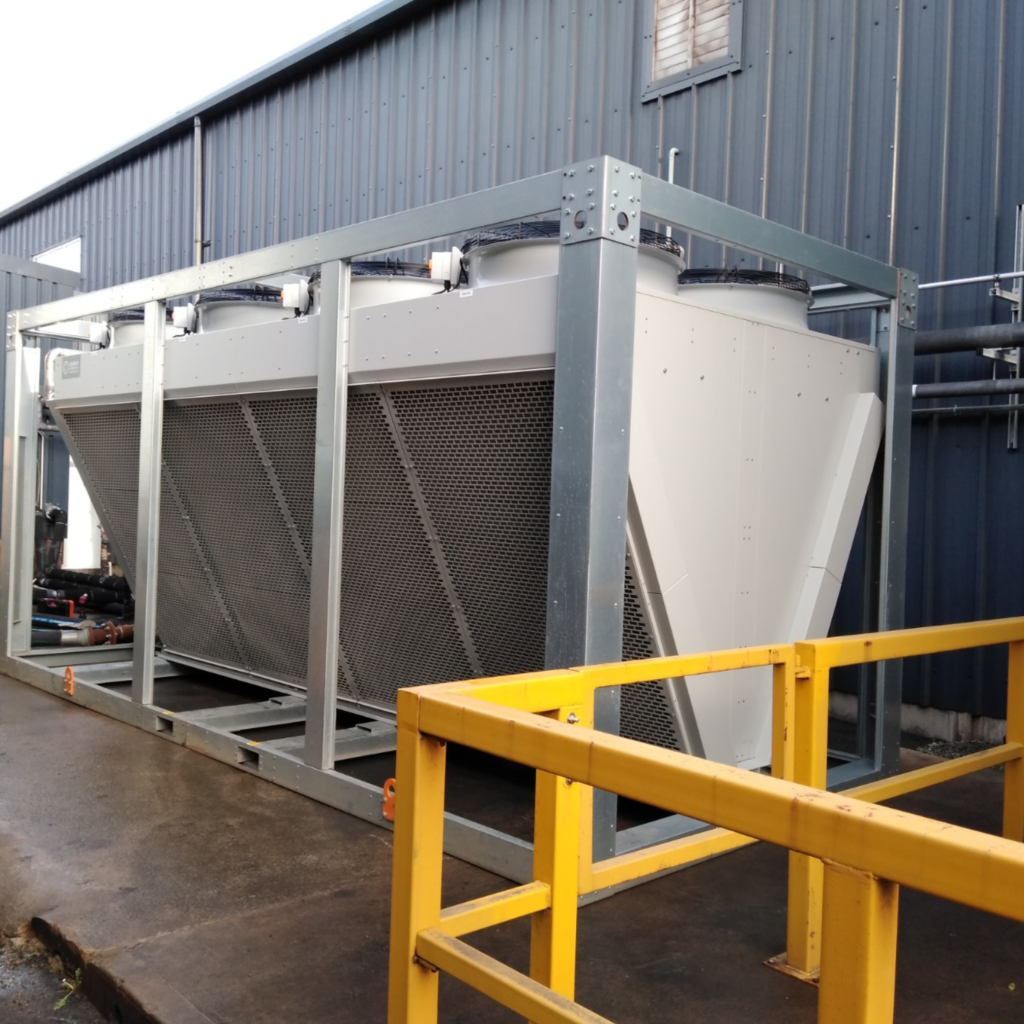Knowledge Hub
Industrial Chillers: Air Cooled Chillers vs Water Cooled Chillers
Whether you’re looking to expand or modify your current processes, or are looking to install a new process entirely, you may require an industrial chiller system for process cooling and temperature control of components and products. The two main types of chillers include air-cooled chillers and water-cooled chillers. But what is the difference between the two and which is most suitable for your processes?
What is a Chiller?
A process chiller, also known as an industrial chiller, provides heat transfer for industrial processes across a number of sectors such as manufacturing, food and beverage, and medical industries. The chiller is designed to remove heat from these processes and transfer it elsewhere through the refrigeration process; this lowers or maintains the temperature of process fluids, machinery & industrial spaces.
Industrial process cooling is essential for the continued operation of heat-sensitive processes at optimal conditions, minimising downtime of machinery and ensuring the integrity of production.
Air-Cooled Chiller Components
There are several main components within an air-cooled chiller. These include:
- Evaporator
- Compressor
- Condenser
- Fans
- Expansion valve
- Control panel
Your industrial chiller may also contain chiller pumps and buffer tanks to aid the steady operation of the circuit.
Each component plays an essential role in industrial process cooling…
Evaporator
The evaporator comprises the first and final stages of the refrigeration process, since process cooling is a recirculating loop process. The evaporator is responsible for drawing heat away from the process fluid initially, and further returns chilled water back to the process.
Condenser
The condenser represents the third stage, where the refrigerant enters the condenser in gas form and leaves as a liquid. Industrial chiller condensers are made up of horizontal pipes and are furthermore a heat exchanger, removing heat from the refrigerant. In an air-cooled chiller, the heat is removed by utilising the ambient air.
Compressor
The industrial chiller compressor plays a vital role in the second part of the refrigeration process. The compressor is used to create pressure which enables the refrigerant gas to travel around the chiller system. The refrigerant is responsible for the phase-change which transfers the hot gas and transitions it into cool liquid.
The refrigerant gas enters the compressor when it leaves the evaporator.
Expansion Valve
The expansion valve is one of the final stages in the chiller circuit. As the name suggests, the expansion valve expands the refrigerant from a liquid state and back into a gas by creating a drop in pressure. It also controls the amount of liquid refrigerant re-entering the evaporator and continuing the refrigeration cycle.
Control Panel
Industrial chiller control panels, made up of sensors, switches and displays, allow operators to maintain control over the chiller’s operation, ensuring complete temperature control, monitoring, and regulation.
Pumps and Tanks
Your air-cooled chiller may also contain chiller pumps and a buffer tank, which are additional systems that can be incorporated into the chiller circuit.
Pumps
Chiller pumps help to circulate the chilled fluid around the system, absorbing heat from the process equipment and transferring it to the chiller where it can begin its refrigeration process. The pump can also be used to maintain the correct flow and pressure of chilled fluid, ensuring that the chiller’s cooling capacity meets the needs of individual processes.
Buffer Tanks
Chiller tanks can act as buffers to sudden changes in capacity, so that the performance of the chiller remains stable in spite of any fluctuations in cooling load. This is particularly beneficial in manufacturing processes that involve intermittent heat generation.
Air-Cooled Chillers vs Water-Cooled Chillers
So, what’s the difference between air-cooled chillers and water-cooled chillers?
Both industrial chiller types achieve process cooling using the refrigeration process, and many of the components are the same across the two circuits. The main difference between air-cooled and water-cooled chillers is the heat rejection medium.
Air-cooled chillers cool the refrigerant using air, which is blown by fans. Water-cooled chillers cool the refrigerant using water, which is dispersed via a cooling tower or adiabatic cooler, and pump.
A water cooling tower is a heat exchanger, which uses evaporation, or evaporative cooling, to expel heat from the circuit.
Benefits of Air-Cooled Chillers
Air-cooled chillers are a popular process cooling solution with many benefits.
One of these benefits is that the fan component within air-cooled chillers takes up less space than the water tower and pump utilised in water-cooled chillers; this means air-cooled chillers often take form as a compact unit in applications where space is limited.
Air cooled chillers are also less expensive to maintain, since they don’t require water treatment, mechanical maintenance of the cooling tower, and more.
Benefits of Water-Cooled Chillers
One of the main benefits of water-cooled chillers is that they are a more efficient process cooling system than air-cooled chillers. Not only is water a more efficient medium of heat transfer than air, but water-cooled chillers are also not affected by changes in ambient environmental temperature, making these chiller types more efficient; this can improve the return on investment in the long run.
Water-cooled chillers are also extremely durable and have long lifespans.
Process chillers are crucial for keeping industrial processes temperature controlled and operating within optimal conditions, thereby minimising machinery downtime and production faults.
However, when deciding between an air-cooled chiller and water-cooled chiller for your industrial processes, consider what the priorities are within your specific application. If you find yourself restricted by space or cost, the air-cooled chiller provides efficiency and reliability within a compact unit. On the other hand, if energy efficiency is a priority within your application, such as in larger applications, water-cooled chillers will offer a more suitable solution.
